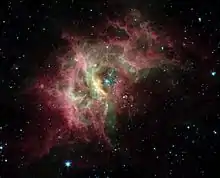RCW 49
RCW 49 is a H II region[1] nebula located 13,700 light years away. It is a dusty stellar nursery that contains more than 2,200 stars and is about 350 light years across.
| Emission nebula | |
|---|---|
| H II region | |
 | |
| Observation data: J2000.0 [1] epoch | |
| Right ascension | 10h 24m 14.6s [1] |
| Declination | −57° 46′ 58″ [1] |
| Distance | 13,700 ly |
| Constellation | Carina |
| Physical characteristics | |
| Radius | 175 ly |
| Designations | RCW 49, GUM 29, NGC 3247 |
RCW 49 is recognized as among the brightest and most massive HII regions.[2]
Other designations for the RCW 49 region include NGC 3247 and G29.[3]
The nebula RCW49, shown in infrared light in this image from the Spitzer Space Telescope, is a nursery for newborn stars. Using NASA's Spitzer Space Telescope, astronomers have found in RCW49 more than 300 newborn or 'protostars,' all with circumstellar disks of dust and gas. The discovery reveals that galaxies make new stars at a much more prolific rate than previously imagined. The stellar disks of dust and gas not only feed material onto the growing new stars, but can be the raw material for new planetary systems.
In 2004 an image by the Spitzer Space Telescope in late 2003, was released showing the nebula in infrared wavelengths.[4] This included and image showing the infrared colors mapped to visible light colors : 3.6 microns (blue), 4.5 microns (green), 5.8 microns (orange) and 8 microns (red).[4] It was noted as being almost 14 thousand light years from Earth, and the infrared light could detect the stars obscured by dust clouds.[4] It was estimated at least 200 of the stars in the nebula have dust disks.[5]
The results of observations of the Spitzer Telescope, including the IRAC camera, have been studied leading to the conclusion that the region is a star-forming region.[2]
In 2014, RCW 49 was identified as a bow shock candidate, along with M17 in a study of Extended Red Objects (ERO's) and Stellar Wind Bow Shocks in the Carina nebula.[6]
See also
References
- SIMBAD, RCW 49 (accessed 4 April 2012)
- "Whtiney, et al - A GLIMPSEof StarFormationin the Giant H II Region RCW49" (PDF).
- Lang, Kenneth R. (2012-12-06). Astrophysical Data: Planets and Stars. Springer Science & Business Media. ISBN 9781468406405.
- "Star Formation in RCW 49". NASA Spitzer Space Telescope. Retrieved 2019-11-08.
- "An "Impossibly" Young Planet?". Sky & Telescope. 2004-06-14. Retrieved 2019-11-08.
- Sexton, Remington O.; Povich, Matthew S.; Smith, Nathan; Babler, Brian L.; Meade, Marilyn R.; Rudolph, Alexander L. (2015-01-01). "Extended Red Objects and Stellar Wind Bow Shocks in the Carina Nebula". Monthly Notices of the Royal Astronomical Society. 446 (1): 1047–1059. arXiv:1410.3518. Bibcode:2015MNRAS.446.1047S. doi:10.1093/mnras/stu2143. ISSN 1365-2966.
External links
 Media related to RCW 49 at Wikimedia Commons
Media related to RCW 49 at Wikimedia Commons- RCW 49 picture and information
- NASA Astronomy Picture of the Day: Cosmic Construction Zone RCW 49 (3 June 2004)
- Devitt, Terry (May 27, 2004). "Milky Way churning out new stars at a furious pace".
- Constellation Guide Westerlund 2 and Gum 29